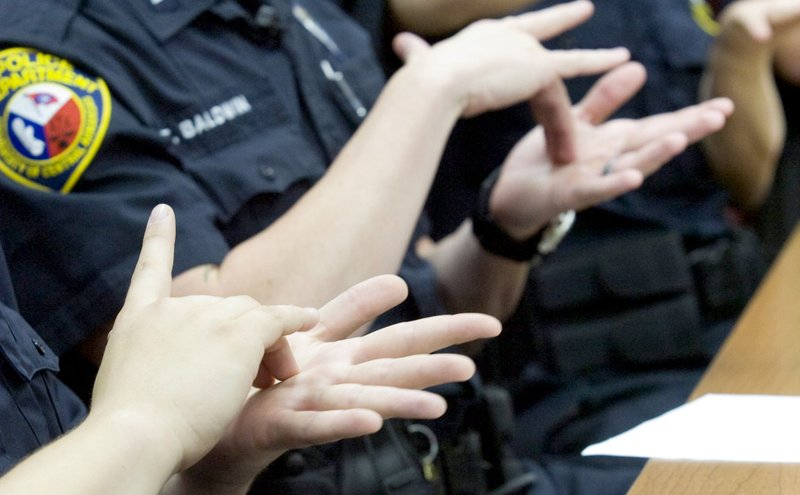How to Sign Draw Blood in Asl
 Members of the UCA Campus Police learn sign language in this photo taken in 2011. (Democrat-Gazette file photo)
Members of the UCA Campus Police learn sign language in this photo taken in 2011. (Democrat-Gazette file photo)
I didn't know how much I didn't know about sign language.
When we were teenagers, my friends and I pretended we knew sign language after we had studied those little cards, about 2.5 inches by 3.5 inches, that showed the alphabet in sign language. It would take forever for me to sign to a friend, "Frank is so cute. I wish he knew I was alive."
We soon gave up on it.
American Sign Language, the main language that deaf people use in North America, uses far more than those 26 letters on the card. Signers use both hands, facial expressions and body posture. Nodding your head, tilting your head, shaking your head or raising your shoulder all send messages to the person watching you. The movements are similar to adjectives and verb modifiers in spoken language.
For example, moving the eyebrows indicates a question will be asked. Eyebrows up means the question can be answered with a yes or no. Eyebrows lowered means the question is a how or a why query needing a longer answer.
A couple of years back, a fake interpreter somehow was hired to sign portions of the funeral for South African statesman Nelson Mandela. The signs were closer to a baseball pitcher's back-and-forth with his coach than to any recognizable language system. Deaf people noticed immediately that, in addition to signing gibberish, he was using no facial expressions.
Just as in talking and writing, sign language can vary in formality, enthusiasm and tone. Imagine the different tones in a news story, a fairy tale and a financial report.
ASL can vary from region to region. Think of the different ways New Yorkers, Texans and Virginians pronounce things. Age and ethnicity of the signer also alter the movements.
Word order is different from spoken English, too, and varies depending on how well the audience knows the topic.
Sentences are sometimes subject, verb, object, but ASL lacks articles, "a," "an" and "the." Forms of the verb "to be" are also omitted. So a literal translation of the active voice might be, "Boy throw ball." The passive voice is a bit different, as object, subject, verb. So it would be, "Ball throw boy."
Sign language also has to change as idioms develop. I feel bad for the first person who had to interpret, "Well, I'll be a monkey's uncle."
Please know that I'm not claiming to have a grasp on ASL. I thought the things I learned were worth sharing, though.
Scientists say that early man communicated with signals before speech. Call me cynical, but I want this confirmed by a witness.
ASL isn't the only sign language in the world. Just as no spoken language covers the world's speakers, no single system of sign language is used around the globe. In many countries, sign language systems developed on their own but took some elements from the native spoken languages.
Frenchman Abbe Charles Michel de L'Epee (imagine spelling out that name with one hand?) commonly gets the credit for standardizing sign language. He opened a school for the deaf in Paris in 1771. He incorporated the homegrown signs that deaf children brought with them when they attended the school.
Thomas Hopkins Gallaudet and Laurent Clerc started the first U.S. school for the deaf in 1817. Clerc moved to the United States from France, where he had taught French Sign Language (FSL). Clerc and Gallaudet created ASL using French Sign Language and the signs that deaf American children used. This is why ALS is most similar to FSL.
Sign language in Britain is much different from American Sign Language. For example, the British use both hands to sign letters of the alphabet.
For about 75 years, researchers at the National Institute on Deafness and Other Communication Disorders have been studying a sign language that hearing and deaf people in a Bedouin village in Israel use. This gives scientists the chance to watch a language as it changes and grows.
I couldn't help laughing when I decided to research Italian sign language. Italian speakers are already so animated (I've written a column about this) that I can't imagine how animated Italian sign language could be. Signers no doubt need to stand a few feet away from each other. (Of course that was all in my imagination.)
Some Japanese sign language uses finger writing, unlike American Sign Language. People draw Japanese characters in the air.
Hawaiian sign language is nearly extinct, and most signers have adopted ASL.
In Ireland, the early schools for the deaf boys and girls were separate, so the languages developed differently. A boy and girl signing might not understand each other. (That part sounds exactly like spoken language across genders.)
Sources: The Sign Language Company, World Federation of the Deaf, The Atlantic, American Sign Language University, Mental Floss, National Institute on Deafness and Other Communication Disorders, Ethnologue, The Sign Language Co.
bkwordmonger@gmail.com
Style on 04/08/2019
Source: https://www.arkansasonline.com/news/2019/apr/08/just-one-language-won-t-do-20190408/
0 Response to "How to Sign Draw Blood in Asl"
Post a Comment